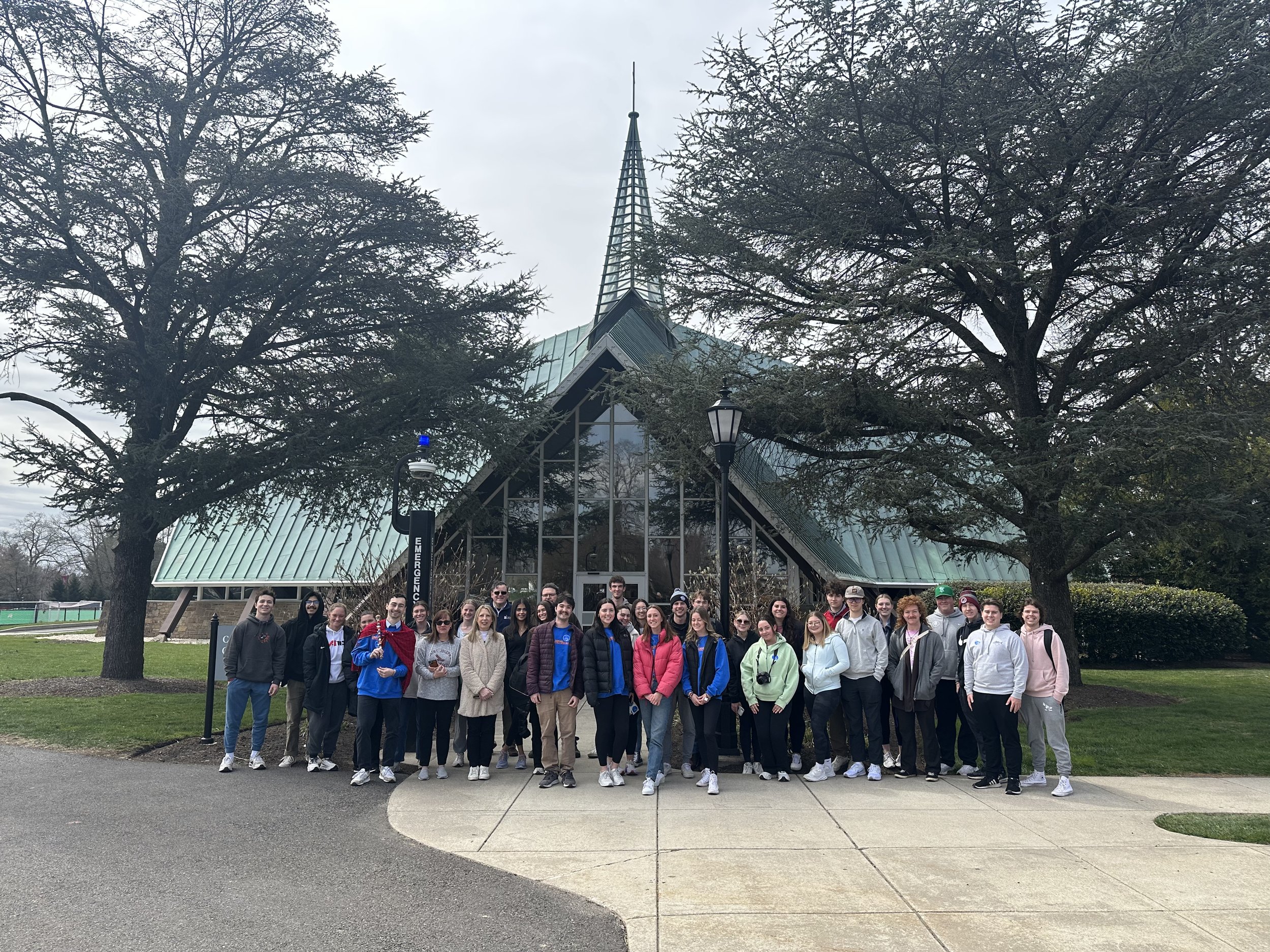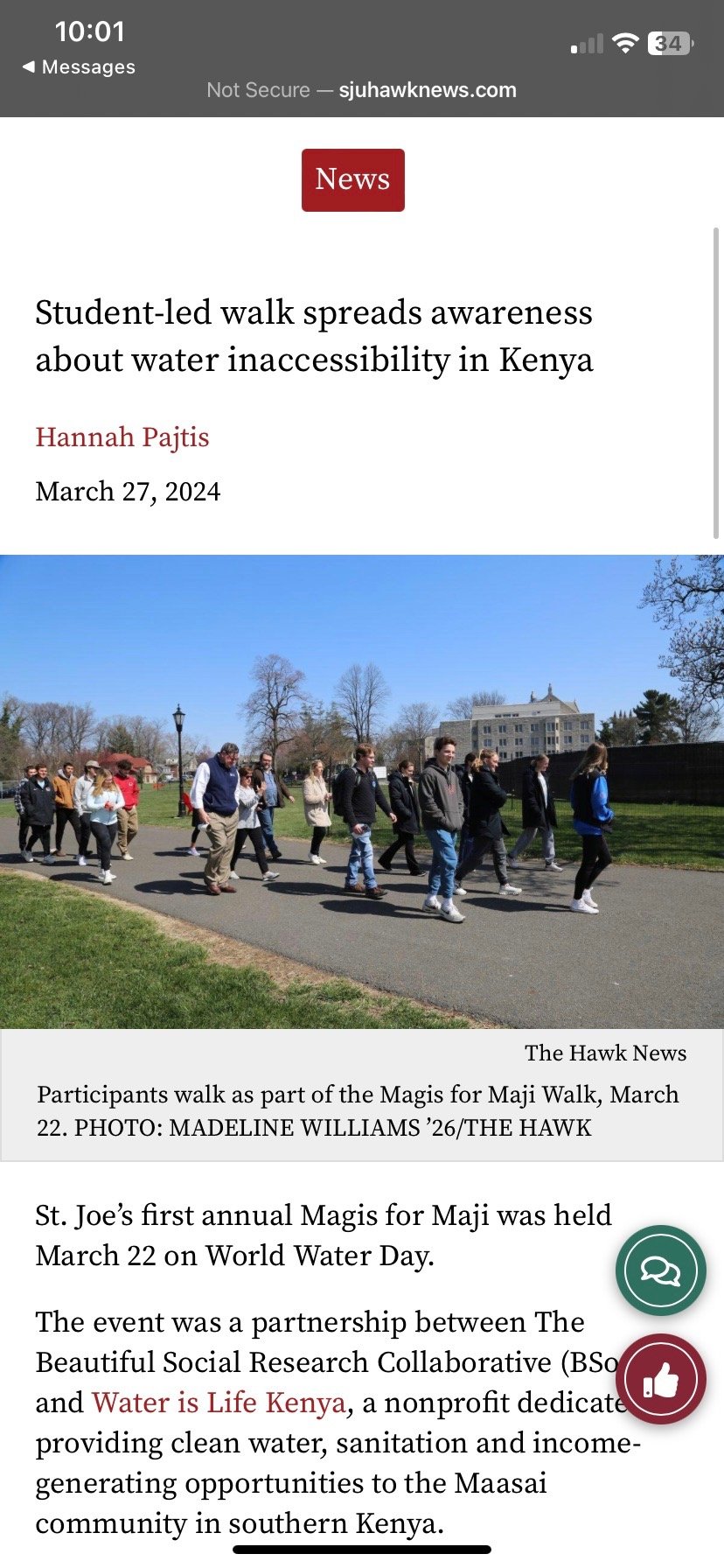Water is Life Kenya:
“Magis for Maji” World Water Day Walk
Spring 2024
Fellow: Hannah Madeya
Kiera Donohue, Jonathan Fritz, Julia Funchion & Ashley Radell
Community Partner
Our community partner this semester is Water is Life Kenya. Water is Life Kenya is a non-profit organization based in Newark, Delaware whose mission is to provide Kenya with clean water, sanitation, and hygiene projects. Although the main project is to increase access to clean water for Kenyan families, WILK also encourages personal, economic, and community development in marginalized communities in Kenya. WILK’s mission directly aligns with the Jesuit values that are taught here at St. Joseph's University. In order to connect the two communities, our group created “Magis for Magi” which was a walk on world water day March 22nd, where we fundraised by selling bracelets made by the Masaii tribe. “Magis” comes from the Jesuit phrase, “live greater” and “Maji” is the Swahili word for “water”. Our efforts this semester was to bring awareness of the crisis where 2.2 billion people are living without access to safe water in Kenya.
Design Question
Our primary goal with our project this semester was to create and spread awareness amongst the Saint Joe’s community about Water is Life and its mission while also taking action. From here we brainstormed a guiding question for our collaboration with WILK this semester, and landed on: how can we increase awareness while also taking action against the water crisis in Kenya? We held many in-person and online strategy sessions with our immediate group and outside partner to come up with the best way possible to achieve this goal. Through careful consideration, we agreed that planning a walk on World Water Day would unite the campus together to achieve both the awareness and monetary funds we outlined in our design question.
Throughout this process, we worked directly with the WILK representative, Aaron Lemma, who guided us through it all. He was able to give us guidance on the mission of the organization so we were fully able to understand what we were working towards. He helped us coordinate bracelet sales and share information about the walk, which resulted in a large success as we had over 50 people in attendance and raised over $1,000 for funding clean water projects. Having an overarching question outlined helped us as a group stay true to our goals, and ensure that our efforts were all tying back to what was discussed in our very first meetings throughout the entire planning process.
Strategic Thinking
The primary goal we were working towards was to organize and put together a walk on Saint Joseph’s campus. This goal was communicated to us by Water is Life very early in the process which gave us plenty of time to plan and strategize for what we wanted it to look like. Through talking together and through virtual meetings with the partner, we realized that we could accomplish two goals at the same time with the walk. We could raise money for the organization through the selling of the bracelets, as well as raise awareness about the water crisis in Kenya in the SJU community and beyond.
To complete these goals, we started talking about how we were going to promote the walk. We used flyers and other methods around campus to reach as many people as we could, some of them with info about the walk and some about the crisis itself. As it went along, we decided to reach out on social media, creating a Magis for Maji Instagram account and making similar posts. This was all to get info and awareness about our walk. To actually get people to sign up and pay for the walk was a different issue. Ultimately, we decided to use the bracelets we were already planning on selling to use as people’s tickets to come to the walk. As we sold bracelets, we got more people to sign up for the walk, making it easier to accomplish our goals.
Co-Creation
To begin our process for a co-creation approach of our collaboration with Water is Life Kenya, we first had to plan and set expectations as a whole in order to properly frame what is expected from each side of the collaboration. In our first meeting with our community partner, Aaron, we decided to have bi-weekly Zoom meetings to share our thoughts and updates for our Water Day Walk to help us stay on track. We'd share individual ideas within our team of five, discuss them, and then make decisions based on Aaron's input. This decision-making method was efficient in helping us make hard decisions easier and at a quicker pace.
Aaron made sure to give us any updates regarding the bracelets, shipping, and quantity. He explained the handcrafted bracelet process in detail during the design phase, which built trust between us. Our team had trust in Aaron and his knowledge of the handicrafts, and he had a lot of trust in us in our on-campus marketing and scheduling. We were able to talk about various logistics with Aaron regarding a lot of the “day of” plans for the walk.
Although our zoom meetings were very effective, I think we can benefit in the future by having a face-to-face meeting with Aaron. Also, visiting the Water is Life headquarters would be a great experience, but it might be challenging due to the distance. Regardless, we were very grateful and happy that Aaron and his partner were able to make it in person the day of the walk and represent the Water is Life Kenya organization as they are the reason this collaboration was such a great success. In the future, I think it would also be beneficial to have a pop-up that includes the rest of the handicrafts made by the Masaai tribe as they were quite popular the day of the walk!
Reflection
The overall results of our walk, raising over $1,000 and having roughly 40 students and faculty members join us in our efforts around campus, made not only a tangible impact but also a memorable experience. Our primary goal was to raise awareness of the ongoing water crisis and spark conversations in the St. Joseph’s community to these injustices and issues. Selling bracelets, sending out flyers and creating an instagram account where we shared different content regarding the walk and the injustices, allowed our audience to be made aware of these issues. Even for the people who were unable to attend the event itself, the outreach we did also contributed to the impact as people made donations and contributed to conversations outside of the event. We specifically branded our walk as “the first annual world water day walk” in hopes to start a new tradition here on campus and allow advocacy and social change towards these issues to continue to grow in years to come.
Check out the Hawk Newspaper article written about our event!








